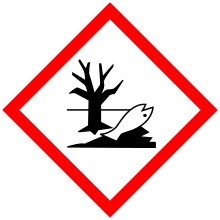Lead(II) azide
| | |
| | |
| Names | |
|---|---|
| IUPAC name
Diazidolead | |
| Identifiers | |
| 13424-46-9 | |
| 3D model (Jmol) | Interactive image |
| ChemSpider | 55508 |
| ECHA InfoCard | 100.033.206 |
| EC Number | 236-542-1 |
| PubChem | 61600 |
| UN number | 0129 |
| |
| |
| Properties | |
| Pb(N3)2 | |
| Appearance | White powder |
| Density | 4.71 g/cm3 |
| Melting point | 190 °C (374 °F; 463 K) decomposes,[1] explodes at 350 °C[2] |
| 2.3 g/100 mL (18 °C) 9.0 g/100 mL (70 °C)[2] | |
| Solubility | Very soluble in acetic acid Insoluble in ammonia solution,[2] NH4OH[1] |
| Thermochemistry | |
| Std enthalpy of formation (ΔfH |
462.3 kJ/mol[2] |
| Explosive data | |
| Shock sensitivity | High |
| Friction sensitivity | High |
| Detonation velocity | 5180 m/s |
| Hazards | |
| Main hazards | Harmful, explosive |
| GHS pictograms |     [3] [3] |
| GHS signal word | Danger |
| H200, H302, H332, H360, H373, H400, H410[3] | |
| EU classification (DSD) |
|
| R-phrases | R3, R20/22, R33, R50/53, R61, R62, R62 |
| NFPA 704 | |
| 350 °C (662 °F; 623 K) | |
| Related compounds | |
| Other cations |
Potassium azide Sodium azide Copper(II) azide |
| Related compounds |
Hydrazoic acid |
| Except where otherwise noted, data are given for materials in their standard state (at 25 °C [77 °F], 100 kPa). | |
| | |
| Infobox references | |
Lead azide (Pb(N3)2) is an inorganic compound. More so than other azides, Pb(N
3)
2 is explosive. It is used in detonators to initiate secondary explosives. In a commercially usable form, it is a white to buff powder.
Preparation and handling
Lead azide is prepared by metathesis between sodium azide and lead nitrate. Dextrin can be added to the solution to stabilize the precipitated product. The solid is not very hygroscopic, and water does not reduce its impact sensitivity. It is normally shipped in a dextrinated solution that lowers its sensitivity. When protected from humidity, it is completely stable in storage.[5] An alternative method involves dissolving lead acetate in a sodium azide solution.[6][7]
Production History
Lead azide in its pure form was first prepared by Theodor Curtius in 1891. Due to sensitivity and stability concerns, the dextrinated form of lead azide (MIL-L-3055) was developed in the 1920s and 1930s with large scale production by DuPont Co beginning in 1932.[8] Detonator development during World War II resulted in the need for a form of lead azide with a more brisant output. RD-1333 lead azide (MIL-DTL-46225), a version of lead azide with sodium carboxymethylcellulose as a precipitating agent, was developed to meet that need. The Vietnam War saw an accelerated need for lead azide and it was during this time that Special Purpose Lead Azide (MIL-L-14758) was developed; the US government also began stockpiling lead azide in large quantities. After the Vietnam War, the use of lead azide dramatically decreased. Due to the size of the US stockpile, the manufacture of lead azide in the US ceased completely by the early 1990s. In the 2000s, concerns about the age and stability of stockpiled lead azide led the US government to investigate methods to dispose of its stockpiled lead azide and obtain new manufacturers.
Explosive characteristics
Lead azide is highly sensitive and usually handled and stored under water in insulated rubber containers. It will explode after a fall of around 150 mm (6 in) or in the presence of a static discharge of 7 millijoules. Its detonation velocity is around 5,180 m/s (17,000 ft/s) .
Ammonium acetate and sodium dichromate are used to destroy small quantities of lead azide.
Lead azide reacts with copper, zinc, cadmium, or alloys containing these metals to form other azides. For example, copper azide is even more explosive and too sensitive to be used commercially .
Lead azide was a component of the six .22 caliber Devastator rounds fired from a Röhm RG-14 revolver by John Hinckley, Jr. in his assassination attempt on U.S. President Ronald Reagan on March 30, 1981. The rounds consisted of lead azide centers with lacquer-sealed aluminum tips designed to explode upon impact.[9]
See also
References
- 1 2 CID 61600 from PubChem
- 1 2 3 4 Pradyot, Patnaik (2003). Handbook of Inorganic Chemicals. The McGraw-Hill Companies, Inc. ISBN 0-07-049439-8.
- 1 2 "Safety Data Sheet of Electronic Detonators, Division 1.4" (PDF). ocsresponds.com. Owen Oil Tools LP. 2014-03-21. Retrieved 2014-06-09.
- ↑ Keller, J.J. (1978). Hazardous Materials Guide: Suppl, Issue 4. Abel Guerrero.
- ↑ Fedoroff, Basil T.; Henry A. Aaronson; Earl F. Reese; Oliver E. Sheffield; George D. Clift (1960). Encyclopedia of Explosives and Related Items (Vol. 1). US Army Research and Development Command TACOM, ARDEC.
- ↑ http://www.lambdasyn.org/synfiles/bleiazid.htm
- ↑ Verneker, V. R. Pai; Forsyth, Arthur C. (1968). "Mechanism for controlling the reactivity of lead azide". The Journal of Physical Chemistry. 72: 111. doi:10.1021/j100847a021.
- ↑ Fair, Harry David; Walker, Raymond F. (1977). Energetic Materials, Technology of the Inorganic Azides. 2. Plenum Press.
- ↑ The Exploding Bullets, by Pete Barley and Charles Babcock, Washington Post, 4 Apr, 1981. Retrieved 28 February 2007.
External links
| Wikimedia Commons has media related to Lead(II) azide. |
